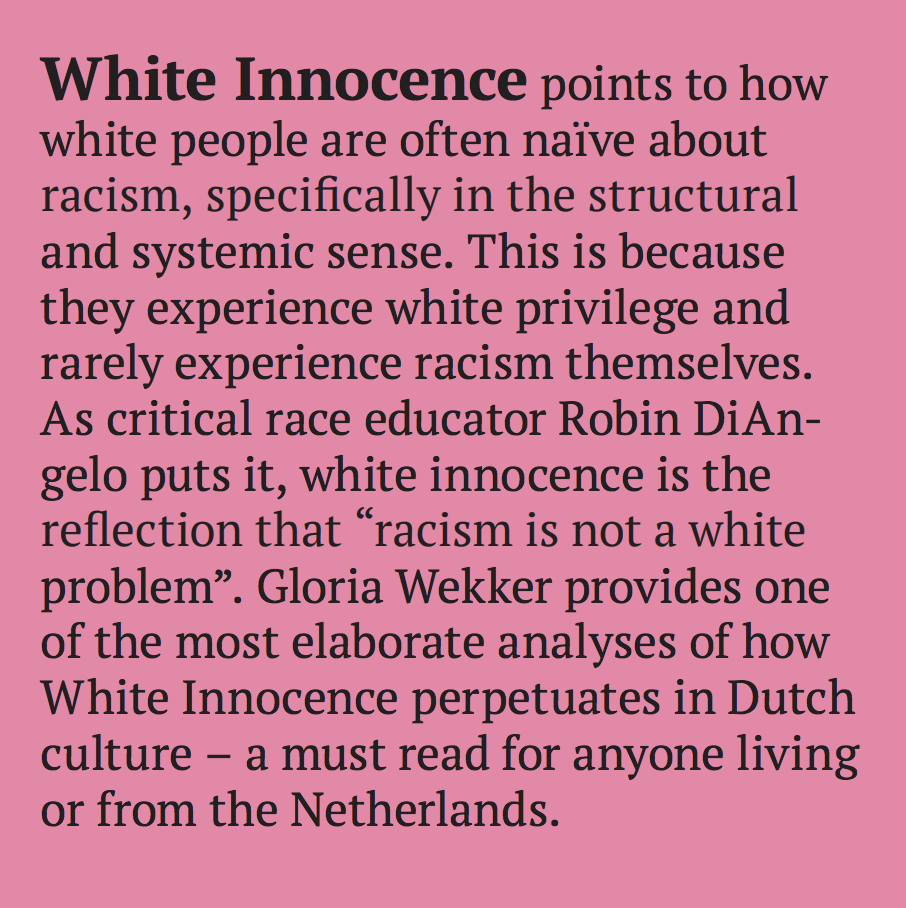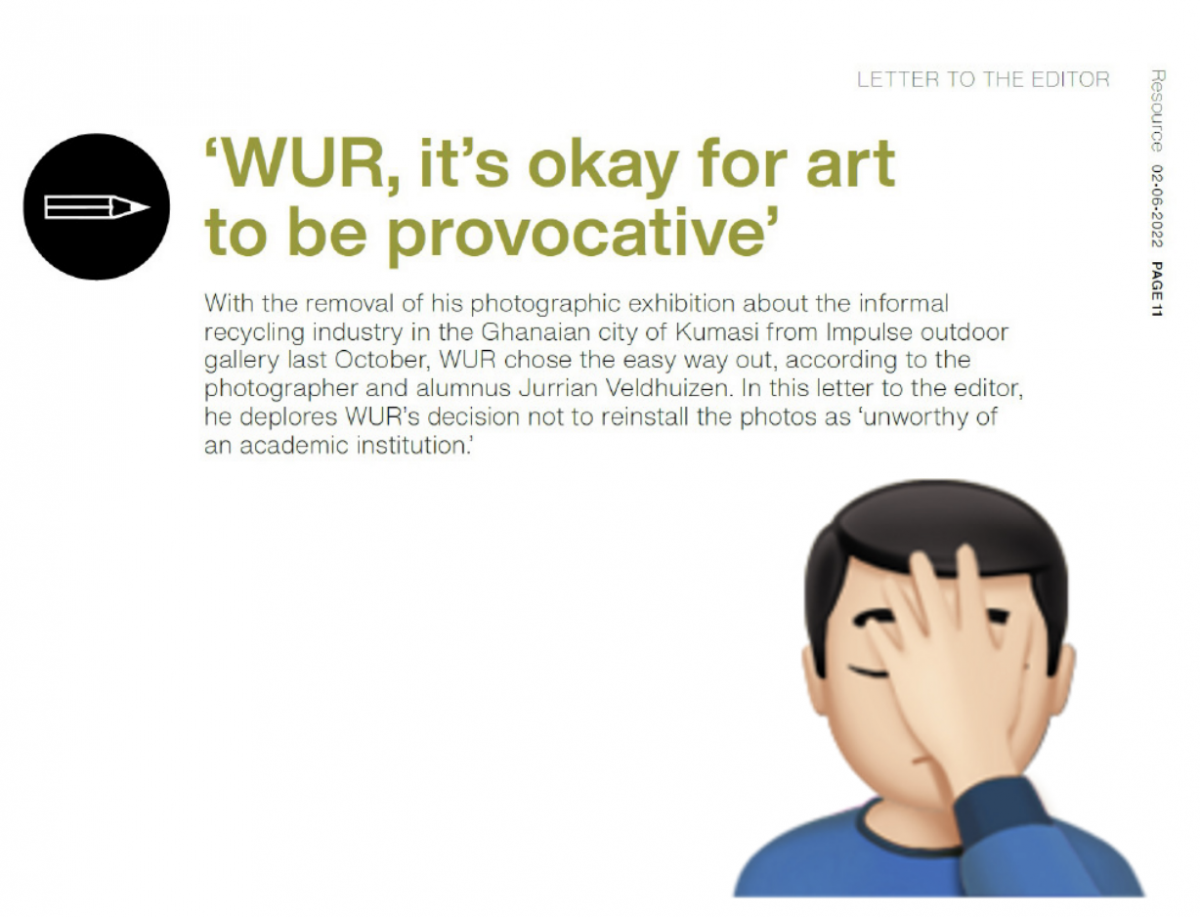The aim of this article is not to say that there are good and bad White people. My intention here is to highlight how White innocence reared its ugly head in the reports surrounding the removal of an exhibition on campus last October. In doing this, racist stereotypes continued to run-rife at WUR. My main message here is that White people at WUR (there’s a high probability that that is you) need to do more work on learning about racism, White innocence in Dutch society, and everything that comes with it.
Before getting started, let me just say that I am also White and that I have also had moments where I stayed silent around others racist behaviour or perpetuated racist stereotypes myself. This is a skin colour that I was born with, and I must now deal with my position and frames of reference that come with it. But avoiding the fact that I am White and that I am living in a country rife with White innocence is not an option. Why? Because I don’t want to support racism. How does this support racism? Well, this article will explain – the rest of the work you have to do yourself.

The case in point
For those who haven’t been following, the shortened version of the story goes that almost a year ago, a building on campus known as Impulse hosted an exhibition that was accused of being racist by the United Community of African Students (UCAS); the exhibition was titled the Power of the Wasted. The exhibited works featured large portraits of Black men holding pieces of trash in a Ghanaian landfill site, these men were referred to as “scavengers” in the exhibition description. After the exhibition was temporarily removed, there was a dialogue between different parties, and it was decided that the exhibition would not return.
An exhibition of this sort is not too surprising at a university with a colonial history, where racist depictions of Africa are not rare occurrences, and where many White students are privileged enough to do their research on case studies on the African continent without adequate preparation on their own positionality – don’t know the term? Look it up.
So, when one student hosts an exhibition of pictures that he took of his research participants in Ghana, it is also not surprising that he misses the mark a little. That’s ok, I don’t want to blame this student. He’s part of a systemically racist university and society and he’s still hopefully learning about all this – he should not take all of the responsibility as some news reports have implied.
One person who has avoided all media attention however is his supervisor, Joost. Research in Ghana is part of his job description, surely he has more of an idea on positionality. Well, apparently not. When the exhibition was removed the supervisor took to the Rural Sociology blog. He kept the racism train running full speed by continuing to repeatedly use the word “scavenger” in his post which UCAS rightfully called out as derogatory and racist. Joost claims that its use in academia justifies its use in the real world. If supervisors can’t reflect on their own positionality as academics and the White-dominant paradigm that their theories come from, what hope does a student supervised by them have.
“It’s just as bad as using the N-word. Working out you can’t say that is hardly rocket science. A bit of googling would have been enough” explained Percy Cicilia Jr. in an interview with Resource. Percy is the coordinator of the Decolonisation, Anti-Racism, Equity and Equal chances (DARE) team at WUR.
News reports contribution to the continuation of racism at WUR
When reporting on the case, the reporters from both the Resource and the Volkskrant chose not to talk about racism – the main point of complaint from UCAS which led to the dialogue and removal of the exhibition. As they reported on the progress of the situation, the journalists let their own White innocence affect their journalism.
In their initial report, Resource decided to avoid the topic of racism completely. Instead, they published a piece that mispresented the voices of the Black people who made the complaint and directly quoted the White people who created the exhibition. White innocence is plain to see here as a White reporter decides not to mention racism although it was a major point of criticism for UCAS and doesn’t even go as far as to provide a direct quote from them. But this was just the beginning, maybe the journalists wanted to learn more about the topic first before publishing an article about racism at WUR.
But for some of those affected, this was enough. UCAS expressed why they were not happy with the coverage in the comments section, and they understandably did not want to engage with Resource anymore. At this point, White innocence had killed Resource’s chances of engaging their voice again. You would think this rejection would push Resource to maybe reflect and try to do some deeper analysis on what racism is and why this exhibition could potentially-maybe have been racist, but no.
Resource then published more articles online where they proceeded to call the exhibition the “Africa Exhibition”. Imagine an exhibition with pictures from one landfill in Amsterdam being called “the Europe exhibition” in a news article, weird right? This is the point where the lack of reflection or understanding of racism by Resource journalists led to more racist stereotyping.
Months passed and the dialogue happened, and the director of the exhibition Sebastiaan advised the executive board that the exhibition should not be put back up. Good job UCAS, the DARE initiative, Sebastiaan and everyone else who worked for this.
‘Why Put it Back if it Hurts people?’ was then published in Resource’s Issue No. 17 print edition. But still there had been little effort or research into what racism is – quite a basic step when you write about racism you would think. Instead, the entire article is framed as an interview with Sebastiaan.
At one point, the interviewer asks Sebastiaan: “In WUR’s explanation of why the exhibition will not return, a link is made with colonialism and racism. Isn’t that far-fetched?”. Here the Resource journalist decides to cast doubt on the possibility of the exhibition being racist in a clearly leading question. For an interviewing expert, this is just poor interviewing never mind White innocence.
The national journalistic treasure Volkskrant then decided it was time to travel all the way to our countryside town and interview some students about what was going on. They managed to mention the word racism thanks to quotes from Percy and Sebastiaan. But then decided to title the column “Over cancelcultuur en Afrikaanse studenten die een punt hebben” (in English: Cancel culture and African students who have a point), framing this as some sort of culture war between students, ignoring the fact that PhDs, staff and people from the public were also critical of the exhibition.
On top of that, they don’t only pit this as a culture war between some students. They go further to centre the claim made by the White student that this was cancel culture, and the Black students get the acknowledgment that they have point. Again, it is important to acknowledge here that Volksrkrant is another White space where the majority of Volkskrant’s audience is mostlty White and satisfying their readers White innocence is important for keeping them reading – same goes for Resource.
To wrap it all off, in issue No. 18, Resource then decided to give their final hurrah to the topic by publishing a letter to the editor from the student who made the photos titled “WUR, it’s okay for art to be provocative”. This art wasn’t provocative, it was racist. YES RACIST – don’t pee your White pants. Again, this publication centered the perspective of the White student since it was completely written by him.
Next to this White innocence escapade, Resource includes some tokenistic pieces where they talk about the ‘dialogue’ that will happen about ‘belonging’ at WUR, and how WUR is getting Ewout Frankema to research Wageningen’s colonial history in Suriname and Indonesia. Ok just a little warning, I am about to flip a lid.
A dialogue about ‘belonging’? Why not a ‘dialogue’ racism? The only people who use the word racism in all these articles are not White. Why can’t the White people say racism? Does it hurt? Ewout Frankema is doing research on WUR’s colonial history in Suriname and Indonesia? Again, he is White. On top of that, this is not just about history. As Percy Cicilia Jr. explains “Colonialism is not just about the colonial past. It is about a dominant worldview – heteronormative and Western – that is seen as normative, standard and right.”
All I’m saying, is that if White people don’t start learning about their positions in this world, their White fragility, their White innocence and how all this leads to the continuation of systemic racism that reinforce centuries old colonial structures – this dialogue and history research shit isn’t going to work.
Look the Jester is also mostly White. But we also see that we don’t need Black people to join to teach us how racism works. White people need to do the work. Read about systemic racism in your society. Read about White Innocence. At least the Wikipedia page if you’re like me and never manage to read books. It ain’t easy but it is sure as hell necessary.

